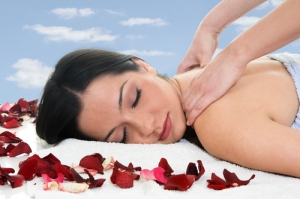Learn the strokes. The most common massage type is a Swedish massage, which uses four different types of strokes to relax and heal the muscles. A full-body massage employs all four techniques:
- Effleurage is a smooth stroke that relaxes soft muscle tissue. Your hands should glide easily over the surface of the body.
- Petrissage involves squeezing and rolling the muscle between your hands, which is useful for loosening muscle tension.
- Friction is the use of deep movements administered with steady pressure in order to cause tissues to rub against one another and stimulate circulation.
- Tapotement is a staccato tap done with the sides or heels of the hands.
Focus on the muscles, not the bones. When you’re giving a massage, the key is to use your hands to work the muscles in the neck, shoulders, back, arms, legs and feet. Use a gentle touch to locate the soft, fleshy muscles, then knead them with your hands. Never exert pressure on a person’s bones, especially the spine and tailbone. If you’re in doubt about whether a spot is composed of muscle or bone, use a gentle, light touch to stroke it, then move on to another section.
Apply pressure, but not too much. Knead the muscles with your fingers, palms and the heels of your hands. Exert a steady, firm pressure to stimulate circulation and loosen the muscles. Don’t use the weight of your body to push down on a person’s muscles, though; you could end up causing pain or even an injury if you press too hard.
- When you apply the right amount of pressure, you should be able to feel the muscle move and relax under the skin. The person you’re massaging might utter sounds of relaxation, but he or she should not cry out in pain. If the person complains, ease up.
- Sometimes it’s difficult to apply even pressure using your hands, especially if you get tired after awhile. Try using a tennis ball instead of your hands. Place the ball against the muscle you’re massaging and use your hand to gently roll it against the body.
Massage slowly. The person you’re massaging should not get the impression that you are in a hurry. Working too quickly makes the massage session less relaxing, and also less effective; you can’t thoroughly massage the muscles if you make quick motions over the surface of the body instead of taking the time to penetrate deeper.
- Use steady, even strokes as you massage, rather than quick, jerky motions.
- Divide the total massage time among the body parts you are massaging. For example, if you planned for the massage to take an hour, spend ten minutes on the neck, twenty on the back and shoulders, ten on the arms, ten on the legs, and ten on the feet.
Communicate with the person you’re massaging. Ask him or which muscles feel tense or tight. Tell him or her to let you know if the massage feels painful or uncomfortable in any way, and be sure to respect his or her wishes during this intimate process.
